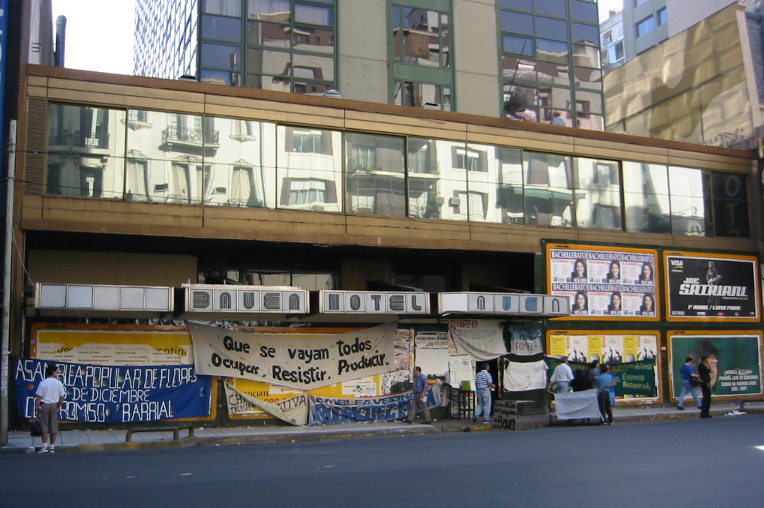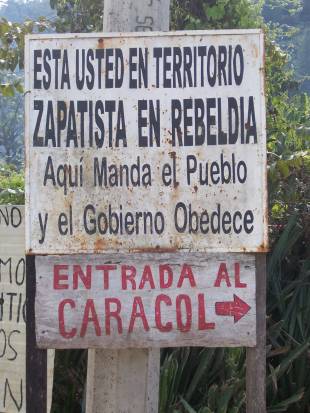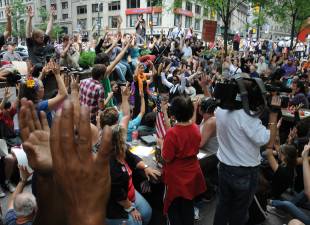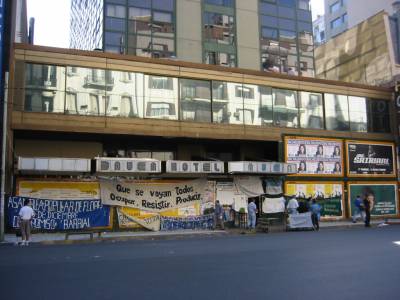Something new is happening – something new in content, depth, breadth and global consistency. Societies around the world are in movement. Since the early 1990s millions of people have been organizing similarly, and in ways that defy definitions and former ways of understanding social movements, protest and resistance. There is a growing global movement of refusal – and simultaneously, in that refusal is a creative movement. Millions are shouting No!, as they manifest alternatives in its wake.
What has been taking place in disparate places around the world is part of a new wave that is both revolutionary in the day-to-day sense of the word, as well as without precedent with regard to consistency of form, politics, scope and scale. The current frameworks provided by the social sciences and traditional left to understand these movements have yet to catch up with what is new and different about them. Specifically, the theoretical frameworks for Protest and Social Movements are not sufficient to understand the emergent horizontal and prefigurative practices. I suggest we think beyond these frames, and do so first by listening to, and with, those societies and groups organizing from below – and to the left.
Photo Credit: Marina Sitrin
Beginning in the highlands of Chiapas Mexico, with the Zapatistas’ emergence in 1994, declaring “Ya Basta!” (Enough!) and rather than making demands on institutional power, creating dozens of autonomous, directly democratic communities, on recuperated land. To Argentina, in 2001with “Que Se Vayan Todos! Que No Quede Ni Uno Solo!” (Everyone Must Go! Not Even One Should Remain!). As with the Zapatistas, the movement focused on creating horizontal assemblies, not asking power to change, but creating alternatives with new social relationships – taking over and running workplaces, reclaiming land, creating new collectives and cooperatives, and breaking from past hierarchical ways of relating – forming what they call a new subjectivity and dignity. Then in 2011 began a similar form of movement around the world – with millions refusing to remain passive in untenable situations. With movements for ‘real democracy’ as many referred to themselves, took over squares and plazas, beginning with Tunisia and then Tahrir Square in Egypt to Spain, Greece, Portugal and throughout Europe and onto the US with the Occupy Wall Street Movement, as well as parts of Latin America, Asia and Africa. And in those spaces of refusal, in various regions around the globe, people were, and in some places continue, to create new social relationships and ways of being. In some places this is still taking the form of direct democratic assemblies, searching for those things around which to organize, in others the movements have evolved to take on questions of alternative forms of production, agro-ecological movements in India and South America for example, defending land from fracking and other forms of extractivism throughout the world, creating dignified housing with the Plataforma in Spain and Shack dwellers movement in Southern Africa, for example, accessible and sometimes free health care, such as the social solidarity clinics in Greece and elsewhere and offering emancipatory education, again, all over the world. And doing so in ways that are participatory and empowering. In all of these movements, women play a central role in the organizing, and while not always “seen” in the sense of a spokesperson, or published author, the fact remains.
An evening assembly in Tunis. Photo Credit: Marisa Holmes
People from below are rising up, but rather than going towards the top – ‘from the bottom up’, they are moving as the Zapatistas suggested,
‘From below and to the left, where the heart resides.’
Power over, hierarchy and representation are being rejected, ideologically and by default, and in the rejection mass horizontal assemblies are opening new landscapes with the horizon of autonomy and freedom. As Kurdish scholar-activist Dilar Dirk so beautifully put it,
“Today, around the world, people resort to alternative forms of autonomous organization to give their existence a meaning again, to reflect human creativity’s desire to express itself as freedom. These collectives, communes, cooperatives and grassroots movements can be characterized as people’s self-defense mechanisms against the encroachment of capitalism, patriarchy and the nation-state.” (https://roarmag.org/magazine/building-democracy-without-a-state/)
Societies in Movement Beyond Contention
The current framework for understanding social movements no longer fits the reality for millions of people – perhaps it never did. Structures and frameworks in general are not a good place to begin to understand societies and people in movement, and rather, listening to and engaging with those people, from below and horizontally, is what will allow us to begin to truly understand them. From there, how it is interpreted is yet another question.
Photo Cedit: Marina Sitrin
The movements described in this short piece paint a very small part of a much larger picture of societies and communities in movement. I have chosen to focus on Argentina, based on the diversity of physical/geographic locations of the movements described as well as the diversity in types of movements. This small piece is part of a much larger global phenomenon from which we could write many dozens of chapters. While using the example of Argentina the movements to which I refer are not “traditional social movements”, with participants mobilized around particular slogans or one demand forethought and pre-organized by a coordinating committee. Neither do they use pre-formed tactics to meet a set strategy? The movements emerge from necessity. Using horizontal assemblies and forms of self-organization overlooking for their needs to be met by those with institutional power. This is sometimes due to their demands on the government or institutions falling on deaf ears, and other times is a part of an initial vision of self-organization and horizontalism. The participants in these movements have generally not been politically active, and most identify as a grandmother, daughter or sister, neighbour. They do not organize with party or union structures and do not seek representative formations. They come together in assembly forms, not out of any ideology, but because being in a circle is the best way for people to see and hear one another. They strive for horizontalism because they do not want to replicate those structures where power is something wielded. They do not begin talking about taking over power but through their grounded organising, they end up creating new theories and practices of what it means to change the world.1)
The phrase ‘societies in movements’ is put forward to help describe these movements. This is not done to provide another theoretical framework, but a loose description that allows for more creative engagement than those so far offered in the contentious politics field. First coined by Raul Zibechi in the early 2000s, I use the phrase both with its literal meaning, societies/communities that are continuously moving, as well as a way to move beyond the structures imposed by social movements. Zibechi puts forward,
“The old pattern of social action began with a strike in a workplace, backed by a general strike and demonstrations. In the new pattern of action, the mobilization starts in the spaces of everyday life and survival (markets, neighbourhoods) putting … societies in movement, self-articulated from within. And not laying siege, as transpired under colonialism two centuries ago, but rather boring from within until cracks emerge …” (2010: 77)
Argentina’s Que se vayan todos! – MTDs and Recuperated Workplaces
On December 19 and 20, 2001 an economic crisis, precipitated by years of unprecedented privatisation came to a head when the Argentinian government froze people’s bank accounts. However,people no longer remained silent. Hundreds of thousands went into the streets banging pots and pans – cacerolando. They were not organized by political parties, or formal grouping, they merely saw their neighbours in the streets, cacerolando and came out as well. There was no specific demand, but a song “Que se vayan todos, que no quede ni uno solo” (They all must go! Not even one should remain!). And It worked. They forced out four consecutive governments. The movement has since been referred to as the 19th and 20th.
Rather than forming political parties or looking to take over the state, people came together and formed assemblies in their neighbourhoods, took over workplaces, and those unemployed neighbourhoods that were previously organized exploded with more people and projects. New movements, groups and networks emerged in neighbourhoods, from media and art collectives, popular kitchens, after-school programs, reflection groups, and a massive barter network2). Due to space limitations this piece will only briefly address a few such formations: the MTDs, Recuperated Workplaces and movements in defence of the land. All such movements function(ed) with assemblies, coining the now widespread term horizontalidad. As it sounds, horizontalidad is a social relationship and was described as a flat plane upon which to communicate. It emerged in reaction to hierarchical forms of organizing, and over time has been described as both a tool and a goal for emancipatory relationships (Sitrin, 2006; Zibechi, 2012)
While some of the movements have shrunk numerically, the forms of organizing inspired by the popular rebellion continue. Many refer to themselves as Hijos del 19 y 20, meaning that their organizing embodies those forms that were practiced in the early assemblies, horizontalidad, autonomy and autogestion in particular. (Sitrin, 2012; Falleti, 2012)
Recuperations
“Occupy, Resist, Produce”3) – this slogan represents one of the most straightforward yet sophisticated movements in Latin America over the past two decades. With over 350 Recuperated Workplaces in Argentina, workers are creating new relationships to production, often challenging the capitalist mode of value production. (DeAngelis 2006; Holloway 2010; Sousa Santos 2006; Zibechi 2009)
The process of workplace recuperations in Argentina arose from economic necessity. As with so many other things related to the popular rebellion, workers took the situation into their own hands. Not organized by unions, parties or any other external force – they self-organized horizontally. Workers are not staging sit-ins, strikes or occupations, they are recuperating, the word recuperar means to recover, reclaim or take back. Implied is that something was already theirs (Ruggeri, 2014). Workers t always insist on this language. They organize by looking at one another, and most of all explain how they organize by describing horizontalidad.
Community is central to any recuperation. Once a recuperation process has begun neighbours always mobilize in support, and over time the workplace becomes a social centre for the community, with evening events, workshops. Increasingly in Argentina, the bases for Bachillerato Populares (alternative high school degree programs) is also organized horizontally by people in the community.
Unemployed Workers Movements Argentina
The Argentine piqueteros or Unemployed Workers Movement (MTD) first arose in the 90ss, and took off after 2001. Generally led by women, unemployed workers in the northern and southern provinces took to the streets in thousands, blocking major transportation arteries and demanding subsidies from the government (Svampa and Pereyra, 2003). The word piquete, as in a picket line, was expanded to mean the full blockade, and later to encompass what was also opened in that moment of stoppage. Instead of using party brokers or elected officials, as was the norm, people came together in assemblies deciding horizontally what to do next. The piquete was developed to stop all transit, not having the option of strikes or other forms of collective action. It was on the piquete that the assembly experience deepened and relationships amongst neighbours strengthened. Supporting one another often for days at a time, created the solidarity and forms of self-organization that became the base for movements in the future. Over time people began to refer to the piquete not so much as the shutting down of something, but the opening of something else. (Zibechi, 2012)
The consistency of the blockades forced the government to give the first unemployment subsidies in Latin America. Within a few years many groups evolved into movements, expanding beyond the piquete. Some movements continued to demand from the state, while others focused their energy on the new relationships and autogestion (self-organization) learned on the blockades. Neka, from the MTD Solano explained,
“The most marvellous idea is not to think of the future and deposit your life in the hands of others who will then guarantee this future, but rather the recuperation of life and to live in a way that is different.” (Neka, 2006: 242)
Movements sometimes squatted lands, built housing, gardens, raised livestock, created alternative education and health care along with many other creative subsistence projects. Most had groups for reflection – discussing their practices and deepening their theory.
With the example of the MTD Solano, some of the initial projects, beyond the bakeries and kitchens were things such as fish hatcheries, shoe production from old tires and acupuncture classes. In the MTD of La Matanza, also outside Buenos Aires, the movement created a school, run by the movement and neighbours, a small sewing shop and an elaborate bakery from which many in the neighbourhood bought products. In La Plata they took over land to build housing, and in the MTD of Allen, in Patagonia they developed a micro enterprise called “Discover”. s a compañera explained, “they named it “discover” because through the MTD they discovered the value of compañerismo, the value of solidarity and discovered experiences that enables one to express oneself beyond words” (Compañera, 2006:109).
The MTDs have largely folded, but the importance of the practice and form of organization is what is crucial. As movements continue to ebb and flow, as movements do – the practice of self-organization over to meet one’s needs, horizontal assemblies, and care-based organizing continue.
Defending the Earth
While corporations continue to land grab, exploit and privatize whatever little commons are left – people around the globe have been rising up. Women are preventing dams from being built in India; indigenous are Idle No More, defending the earth; entire town and villages have organized to prevent airports, roads and mines from being developed in France, Italy and Greece; thousands throughout the Americas have used their bodies to block the construction of pipelines intended for fracking, and throughout Latin America there are struggles everywhere against mining and the exploitation of land and water. The use of direct action often comes first due to the lack of response from the governments in each location, or worse, their complicity in the exploitation of the land. From the mobilizations and blockades, new relationships emerge, and have become the root of many of the new forms of self-organising among communities.
Argentina
“The Union of Citizens Assemblies emphatically organizes with horizontalididad and with absolute independence from NGOs, political parties and the state. We use direct action and self-organize autonomously.” (Emilio, 2014)
What began with a few neighbours meeting to find out what the ramifications of Monsanto in their town might be turned into hundreds and eventually thousands (including supporters from outside the town) creating ongoing blockades of the construction processes. They stopped Monsanto and its plan to create the largest genetically modified seed processing plant in the world. As Vanessa Sartoris, mother of a toddler who grew up in the assembly and is one of the organizers of the Malvinas Assembly, like so many of us, reflected
“Our resistance began in 2012 when a group of neighbours came together … Within two weeks we organized ‘The Assembly of Malvinas’, made up of neighbours – almost none of us had any organizing experience from before. We organised in a horizontal way, didn’t have any leader and made all decisions together. We began to study their [Monsanto] movements and see which days things like cement trucks were arriving. Then we would create human barriers, standing in front of the trucks with banners and flags that said “Out Monsanto” and the “Assembly of Malvinas”. In September 2013, we organized a festival at the gates of the construction site called “Spring without Monsanto”. There were tons of people from all over Argentina. There were neighbourhood organizations and community groups; people from the south who were fighting a mining project; and the assembly from la Rioja; there were indigenous from Chaco, Paraguay and Brazil who are also fighting against genetically modified soy; there were many from Uruguay and even Central America. It was then that we decided to create a permanent camp at the gates of the site until Monsanto withdrew.
On January 8th of 2014, the courts in Córdoba decided that Monsanto had to stop the construction and that their permits were illegal. (2015)
While there was a legal victory, people in Malvinas and throughout Argentina stayed vigilant and organised. Assembly participants reflect that it does not matter who is in government, the only way to stop Monsanto and defend the earth is from the ground and being together
“We did it and so can you.” Vanessa reflected, “If someone had told me, ‘Your future is this’ I would not have believed it, nor anyone else in the assembly – we are all neighbours – women housewives, students, teachers and workers, regular people.”
A few hundred kilometres to the northwest of Malvinas is La Rioja and the mountain of La Famatina, neighbours and communities in the region have been organizing in local assemblies since early 2007 to prevent the strip mining of the mountain by international mining companies. Neighbours in the town as well as neighbouring towns and villages, coordinated in the union of Citizens Assemblies. They all created blockades and prevented every attempt by different corporations to exploit the mountain. The assemblies consisted of “regular people” (just like other land struggles in Latin America).
“Close to the fire are a retired 80 year-old watchmaker, a public worker, an engineer, a walnut producer, a teacher, a retired policeman, and a housewife. They are part of a big net of citizens’ assemblies, those strange horizontal organizations without bosses, without leaders, without political parties, which are open to any member of the community. They hold the blockade during the night…and the blockade will continue until the definitive removal of the company.” (Lavaca 2007)
The first company to withdraw was Barrick Gold, then Shandong Gold and finally the Osisko Mining Corporation. Those involved in the movement say “the struggle to defend La Famatina is forever.” (https://www.facebook.com/famatina.nosetoca?fref=ts) What began as a defence of the mountain, earth and water has evolved into a new space of creation. On the road blockades, as with the piqueteros years earlier, people organize to cook together, arrange medical support, and entertain themselves through music, dance and storytelling. At the heart of all this activity is the assembly. People in each town and village organize regular open assemblies in their squares and plazas where anyone can speak and be heard.
As John Holloway wrote, it is not by looking to the state that new worlds are created, but “we fight the state by being something else.” (2012)
1)
The descriptions found in this piece come from prior fieldwork in the locations cited, some variations on the descriptions and interviews have been published by myself.
2)
The barter network in Argentina was the largest ever recorded, with between 4-7 million people participating, and exchanging goods, services and using representations of value in their exchange.
3)
This slogan has been borrowed from the Movimento Dos Trabalhadores Rurais Sem Terra (Landless Rural Workers Movement) in Brazil, whose slogan is, “Ocupar, Resistir, Produzir.”








